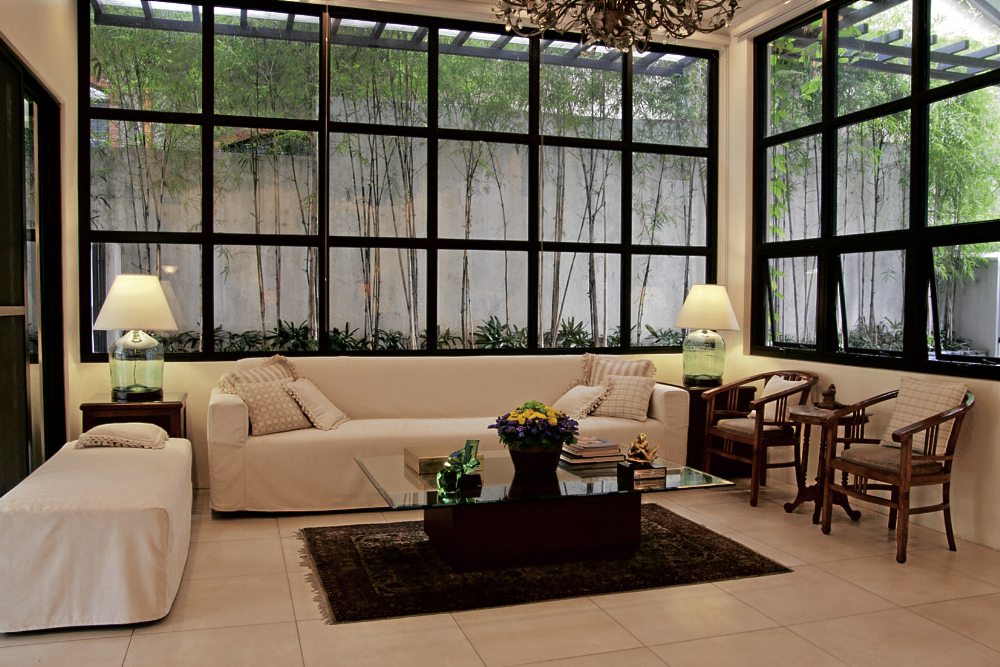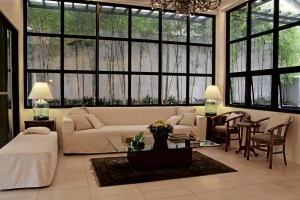
Nationalist, AUTHOR, playwright and film critic Nicanor Tiongson recalls getting into a long discussion with some visitors about what defines a Filipino home.
Visitors to his home expected to see the stereotyped cutwork transoms, hardwood wall panels, cane-backed furniture and turned balusters. They found none of these in his new house.
“They felt my house was not Filipino. I said, ‘You are being nativistic in equating the Filipino home with bamboo, objects that come from the past and bricks to look like Vigan.’ That is the viewpoint of an outsider. Our viewpoint as Filipinos shouldn’t be like that. Otherwise we freeze ourselves in time and don’t grow anymore.”
For so long Tiongson lived in a four-story house which had all the romantic elements of a bahay-na-bato (traditional house with masonry on the ground floor and timber on the second floor) with a tower, a spiral staircase, a courtyard. It was built with salvaged architecture elements and laden with traditional tiles. But climbing up the floors became taxing for him.
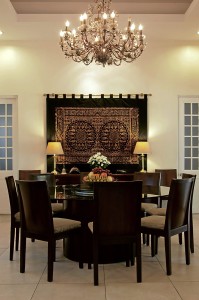
symmetry,” says architect Rosario Encarnacion Tan. The tanguile dining set is designed by Dargo. The Italian chandelier lends formality to the informal setting.
He lived in a condominium for five years, but found it too small for his possessions and books. He also missed the micro climate created by a garden.
When he commissioned architect Rosario Encarnacion Tan to build his “retirement home” in Quezon City, he wanted it to be a place of retreat.
“When you come home, it’s restful. I wanted simple lines,” says Tiongson.
It is the quintessential urban Asian home. The design is an L-shaped bungalow, its structure derived from the native hut, which is enveloped by a verandah.
The dining area is the house’s focal point. It is surrounded by pockets of greenery and a Japanese-inspired garden, both of which make the house look cool and feel cool, and enhance the aesthetics.
There are in-between spaces in the form of a gallery-like hallway and a colonnade or volada.
“I wanted covered walks. I find the columns elegant,” says Tiongson, referring to his volada.

A wing has three successive bedrooms with connecting doors.
“There is privacy so you can keep the doors closed. But when they’re open there is circulation. This applies the principle of the bahay-na-bato which uses cross-ventilation,” says Tiongson.
“It’s like a monastery which ends in a reflectory. In this case, it’s the library but we end up in the dining room,” he adds.
The rooms have high ceilings for effective air flow. Built with porous walls and wide openings, the house is soaked in natural light and enjoys fresh air.
Tiongson defines the Filipino house as one that responds to the climate. Visitors observe that his house is more Japanese in its simplicity.
“You should welcome influences. There is a philosophy with the Japanese house—it encourages you to reflect. I feel that we should introduce this philosophy to Philippine architecture,” he says.
Japanese
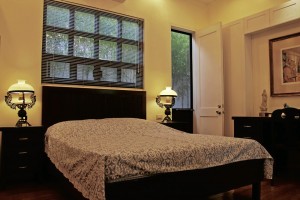
He points out that typical Filipino homes emphasize the exteriors over the interiors: “The Japanese house is the opposite. When you see it from outside, it’s not impressive. But what is impressive is its soul. It comes with using things from nature and creating a look that is not contrived.
“We should start moving away from the borloloy. That was part of our history, but we don’t need to stay there. As we respond to the times, we should move toward that which is more contemplative, rather than putting up with an image. That’s what guided me in designing this house.”
Tiongson says the bahay-na-bato was relevant for a certain period, climate and social class. Over time, community planning has changed and subdivisions developed. Houses have to follow subdivision rules. The social class that once lived in the bahay-na-bato is no more. Information technology has made the world a global village.
“What continues is the tropical climate that we respond to. The principle is to live harmoniously with the climate. The house doesn’t try to dominate (the environment),” he says.
Architect Tan explains that the back part of the house is the most vital element as all the rooms open to the east.
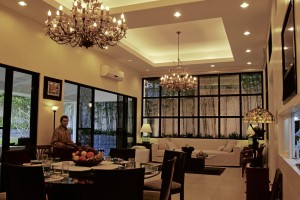
“The beauty of the house lies in height, size and flow of space that was measured to the last detail. The house also takes delight in garden spaces and their connection with the interior spaces,” says the architect.
The stone fence, which follows the hilly contours of the site, is like a buttress. Once used as cobblestones in Intramuros, the black stones were sourced from Binangonan.
“When hit by sunlight, different patterns appear on the stones. You realize they have been cut by hand,” says Tiongson.
The pocket gardens are lined with elegant pole bamboo. The backyard takes after the classic Japanese garden which shows a balance of textures—grass, black river stones, a sculptural frangipani tree and some old jars.
The eye rests either on the tree or stone circle rather than being overwhelmed by too many elements.
Memories
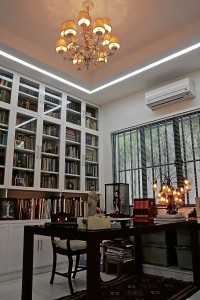
The heart of his decor is the intermeshing mementos from his theater work and family treasures. His taste was shaped not only by his ancestral home but also by books and travels.
“Malolos is such a big part of me. I grew up in the parencillo—the mestizo Instik (Chinese-Filipino)—where the women of Malolos lived,” he recalls.
Tiongson’s book, “Women of Malolos,” documents how the well-to-do Chinese-Filipinos advocated for a school so they could learn Spanish. Their bravado in presenting the letter to Governor-General Valeriano Weyler threatened the friars. One of these women was the author’s great-grandmother Eugenia Tanchangco Reyes.
“Nic has so many things in his life,” says Tan. “Thus, we made the walls white and free of ornament.”
His library is a repository of memories. The chair is an Art Deco reproduction from his ancestral home. He keeps the Tanchango-Reyes’ leather-bound album which stores family pictures dating back to the 19th century.
A relief of the Purisima Trinidad (Holy Trinity), circa 1850s, lends a historical presence.
The picture of the late Atang de la Rama is reminder of how Tiongson rallied for her National Artist for Theater award.
An Art Nouveau chandelier, with its floral and leaf patterns, draws attention to the lofty ceiling.
“I was in college when I first saw the Wisteria lamp I fell in love with. Art Nouveau became an obsession. I still don’t have it. The whole movement was soulful,” says Tiongson.
The foyer displays a mix of artworks such as Peter de Guzman’s sculpture relief and an illustration of the old Ragodon Church of Magarao in Camarines Sur. They co-exist with a Chinese mirror with a rooster design, an antique jar from Zamboanga, and stools made from a fallen caimito tree.
Along the hallway, the formal arrangement of Rafael del Casal’s costume sketches for Tiongson’s play “Filipinas c.1887” is a contrast to the casual scattering of Oriental and local antiques.

In the living room is Tiongson’s bust by sculptor Julie Lluch. The setting becomes modern Filipino when paired with an antique stool from Malolos, a marble-topped table from Jo-Liza, and a mid-century rocking chair.
In the dining area, a tapestry which says “Allah, bless this house” was a gift from the family of the wife of Nur Misuari.
In one bedroom, the series of framed costume designs for “Realizing Rama” by the late Salvador Bernal, brings back memories of his collaboration with the National Artist.
The kitchen is another source of childhood memories. The cabinets are made of different kinds of glass, with a layering effect which is typically Filipino. The shelves display inherited glassware.
After the shoot, Tiongson shows the Bulakeño hospitality. The table is an abundance of fresh fruits, cheeses, nuts, breads, pastas, juices and coffees.
Just as as the spirit is nurtured with the abundance of heirlooms and artworks, the body is nourished with the bounties of the earth.
PHOTOS BY RENE GUIDOTE

